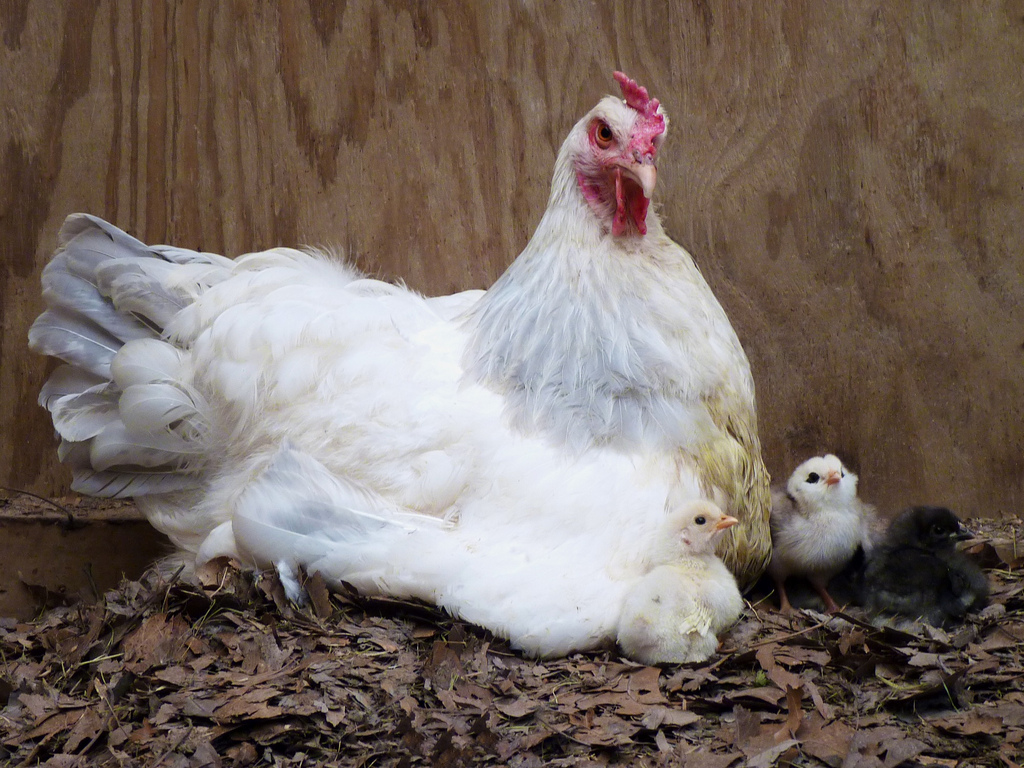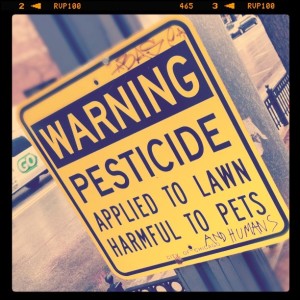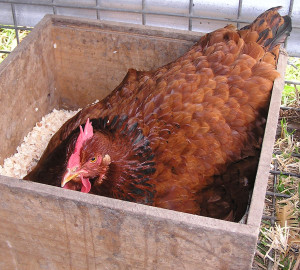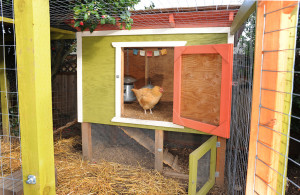On this episode of the Urban Chicken Podcast, I answer a new set of listener questions on a variety of topics. How long after your husband treats your lawn with a chemical weed and feed can you safely put a flock of birds on it? What do you do when you have multiple hens go broody at the same time? How do you protect your flock from predators?
There is tons to learn in this episode – including a brief look at a news story involving chickens which sounds more like an Austin Power’s movie plot.
ISIS STUDYING AUSTIN POWERS’ MOVIES
Just when I thought the world could not possibly get more ridiculous, I am proved wrong. In a recent news story out of the U.K., I discovered that Isis (a violent, extremist Islamic group based in Iraq and Syria) is apparently basing their military strategy after Dr. Evil lately.
In a move that is about as reasonable as sharks outfitted with laser guns, Isis militants are now strapping C4 plastic explosives onto the backs of innocent chickens. These poor unwitting birds are then set loose to wander into the camps of Isis enemies. Once inside, Isis militants remotely detonate the explosives strapped to the chickens – killing both the bird and humans. Everything about the Middle East disheartens me – including the chicken suicide bombers.
CHEMICAL WEED N’ FEED AND YOUR FLOCK
What can you do when your husband is obsessed about his lawn as an Augusta golf course groundskeeper?
UCP listener Susan recently wrote and told me that her husband has regularly been using Scott’s Weed n’ Feed granules on their yard lawns and his last application had been two weeks earlier. Susan now has some young pullets and wants to be able to put her new hens out in the yard, but is concerned about their safety. The safety label for the toxic product that her husband was using clearly states,”this product is not intended for use where grazing animals such as chickens are.”
Susan wanted to know the answer to two questions. First, when if ever, will it be safe for her new flock to scratch and peck around her family’s backyard lawn? And how can she appease her husband’s lawn obsession in a manner that is effective (i.e. the lawn lives up to HOA standards), but is not completely toxic to her hens?
After some researching on-line, my long time suspicions were confirmed – not only are chemical herbicides no bueno for grazing animals such as chickens, but they are also dangerous to humans in general. My research however, did not however answer Susan’s question though – when could her birds safely be let loose on this chemical herbicide treated lawn. I decided the best answer would be to go to the source, so I contacted the Scott’s company directly. Here is a link to an unabridged transcript of my on-line customer service chat with a Scott’s representative about their product – Chat Transcript.
In a nutshell, Scott’s does not know when it is safe for chickens to be let loose to graze on lawn after being treated with their product. The only thing that Scott’s customer service representative could say was that the Environmental Protection Agency (EPA) suggests that a full year pass before allowing grazing animals on previously treated grasses with Scott’s products. When I asked about other options, the Scott’s representative suggested that the lawn and all of the top soil down to the moisture line, which you find using a hydrometer gadget (here is one example: Dr.Meter® Moisture Sensor Meter, Soil Water Monitor, Hydrometer for Gardening, Farming, Indoor/Outdoor Use (4-in-1 Advanced Version) and replace all of that topsoil with untainted dirt. Hmmm…that seems an impractical and overly burdensome solution!
A beautiful lawn does not require chemical treatments, which simply poison your ground and kill all the beneficial insects (along with the bad ones). There are now organic lawn care services which will come to your house and treat your lawn using natural substances or you can buy organic “weed n’ feed” and treat your own yard. Here is one example of an organic, granular “weed n’ feed” product: Espoma Organic Weed Preventer – 25 lb. CGP25.
Any product that takes a full year to clear out before the EPA thinks it is safe for chickens is not a product that I would want around me or my family!
DEALING WITH MULTIPLE BROODY HENS
The next question comes from UCP listener Sandy who wrote to me and explained that she had two broody hens and wanted to give them some fertilized eggs to hatch. Sandy asked for any tips or suggestions I might have.
My answer to Sandy’s question has three parts. First, it is fairly easy to add fertilized eggs under a broody hen on the next. She is so excited to be sitting on any eggs that she won’t mind some ones to work on that might actually hatch. To make things easier and to save your hand from getting pecked, I suggest waiting until nighttime to slip the fertilized eggs under your broody hen.
Second, you should always separate a broody hen from the rest of the flock. Other hens in the coop do not appreciate having a broody taking up the favorite nesting box. Annoyed hens wanting to use the popular nesting box will commonly peck at (and sometimes injure) a broody hen. In some cases the abuse from non-broody hens can be severe enough to force the broody off of her nest and eggs. Left unattended, these fertilized eggs will die from the shift in temperature. It is best to put your broody hen into a “broody bay” right away. For those of you who are unfamiliar with the term “broody bay” — it is simple a confined, comfortable enclosure separate from the rest of the flock (think sick bay but just for a broody hen.) Additionally, you cannot leave a hen to hatch chicks in a general coop under any circumstances. Without exception, hens will attack and kill newly born chicks under a different hen. Just for chick safety, you need to set up a secure safe area for the broody to set to term on her eggs and rear her chicks.
Lastly, you cannot leave two or more broody hens together as they will disturb each other and possibly kill the newly hatched chicks. My sister recently learned this lesson the hard way. She had put 3 broodies all together in broody bay with their own fertilized eggs to hatch. However, once one hen’s egg hatch, the other broodies tried to steal that chick from its mother. They not only abandoned their own eggs that they hadn’t finished setting on, but ultimately all of the fighting over the chick ended up killing the poor hatchling.
One final reason to set your broody hen into her own private broody bay is to help keep her determined to finish the job. If left out with other hens, broodies will often lose the will power to go full-term and abandon the eggs. A private broody bay keeps mama hen focused on the end goal.
PREDATOR PROOFING AND PROTECTION
Finally, I had questions from two UCP listeners Mary and Cara who live on opposite sides of the United States (in California and upstate New York respectively) who both were concerned with protecting their flocks from predators.
Mary, who lives on a canyon in the Los Angeles area was particularly worried about coyotes and hawks. She asked whether the physical presence of a person, in addition to a temporary fence around a free-range area in the yard would be enough to deter the coyotes and hawks from grabbing a chicken and running away with it? She also asked about using lightweight netting to cover the chicken’s free-range area, but was concerned if a bird of prey would simply tear through it to get to her hens?
Cara, who lives on 24 acres outside of Syracuse, NY had a few similar questions as she was researching getting chickens and wanted to know what she needed to do to keep her flock happy and safe. Cara asked my opinion as to whether it would be practical to convert a concrete floored backroom in a barn into a chicken pen? She also what to know how much “range” do chickens need? And lastly, would it be necessary to put up her chickens every night to keep them safe from the predators in her area?
All birds like some time out of the coop and run to flap their wings, fake fly a bit and chase each other around. How much free-range time do chickens need is a matter of personal opinion. In my case, my birds get to come out of the coop when I am at home after work. This allows them a couple hours each evening to get in some exercise in freedom.
Unequivocally, it is imperative that a chicken owner put his/her birds up in a locked and secured coop each and every night – especially if you have known predators in the area. Even if you don’t think you have any predators in your area, I assure you that you’re mistaken and that they would LOVE to find your chickens unprotected. Chickens are virtually blind in the dark and they have no claws or gnashing teeth to with which protect themselves. Literally, chicken owners are their only protection from dying a grisly death as the victim of a predator attack. If you are going to keep chickens, give them a safe home.
Chickens can have a concrete floored run, which would be quite predator proof. However a concrete chicken would also be rather hard and cold on the chickens’ feet come wintertime in Syracuse, NY. Birds like to dig (which helps keep their nails naturally trimmed) and bathe in dirt. I would suggest giving your flock a dirt floor in their run and perhaps making their coop in the the concrete floored room, with the floor covered in litter such as straw or wood shavings to make it a bit warmer and softer for the flock.
The presence of humans generally does help greatly to scare off predators. The problem is that one may have the best of intentions, but not be able to fully follow through with those plans. Realistically, even if Mary were to plan to be outside accompanying her flock whenever they were free-ranging, she will at some point leave them unattended. There will be the unexpected knock at the door, answering the phone call inside or need for a pee-break that will take Mary away from her chickens. Predators are opportunistic and may lay in wait for those times when her hens are left alone, even if just temporarily. The other side of this debate, is the fact that your flock will always (to some degree) be at risk to attack by a predator unless kept locked up at all times. It is a calculated risk. I let my chickens run around my backyard without me being with them at all times. Could a raccoon or hawk get them while I was not watching them – absolutely. It is a chance that I am willing to take for their happiness, since they are very unhappy when they do not get range time. It is sort of like having children and letting them go to the park down the street alone. Could some psychopath kidnap them – yes, but is that very likely, no. You take a chance on the odds for their happiness and development. Despite all of our efforts we cannot keep anything or anyone that we love 100% safe all the time. We have to just do our best and be willing to accept the risks.
Lastly, I speculate that even lightweight netting would be serve as a deterrent for owls and hawks from striking at Mary’s flock. Even if the netting is not of the strongest tensile, I think that a bird of prey would still avoid it to prevent becoming entangled in it. That being said, I think my answer is true for Mary’s situation where the netting will be used just for a daytime, free-range run’s cover. I would not use this light weight netting as the permanent roof for the coop or some other area where the flock is kept at night. Dexterous predators, such as raccoons or polecats, would easily rip through this netting to get at a “chicken dinner.”
Despite the best of efforts, as chicken keepers we must be aware and ready for the fact that we might lose a bird or two along the way. Sometimes the predators are more clever than the humans. Don’t let this risk stop you from having and enjoying chickens. All things worth doing in life have an amount of risk involved with them.
CHICKEN NEWS:
- Foreign Policy Group – Death to Infidel Chickens – NEWS ARTICLE
- The Metro – Isis Using Chicken Suicide Bombers – NEWS ARTICLE
MAIN SEGMENT:
- Transcript of my On-line Chat with Scott’s Customer Service Rep – LINK
- Amazon – Espoma Organic Weed Preventer – 25 lb. CGP25
- Amazon – Dr.Meter® Moisture Sensor Meter, Soil Water Monitor, Hydrometer for Gardening, Farming, Indoor/Outdoor Use (4-in-1 Advanced Version)
- Eartheasy.com – Lawn Care Chemicals: How Toxic Are They? – ARTICLE
- Toxicsaction.org – Refuse to Use Chemlawn – ARTICLE
- Mindfully.org – Glyphosates (Used in Round Up) – FACTS SHEET
SALLY’S SIDENOTES:
- Support the Urban Chicken Podcast by shopping Amazon starting here: Amazon
- If Amazon is not your thing – you could also support the show HERE
Podcast: Play in new window | Download | Embed
Subscribe: Apple Podcasts | RSS






